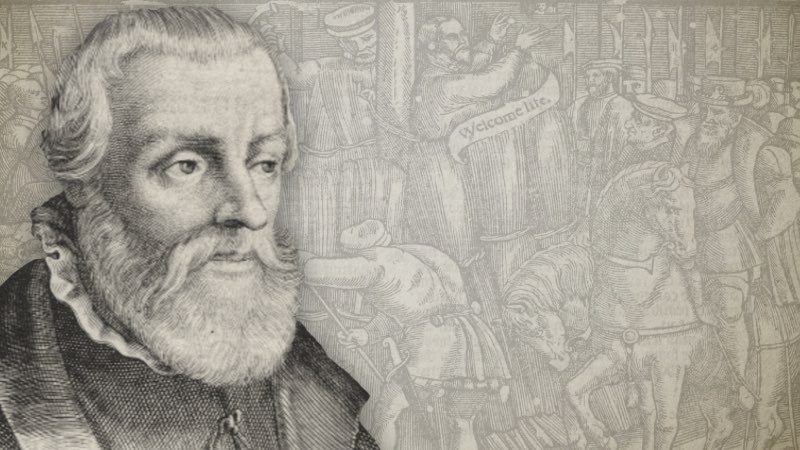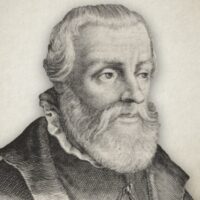
The Life And Martyrdom Of Laurence Saunders
The Sower 1880:
Laurence Saunders, the subject of our present paper, was the second martyr in Queen Mary’s reign. His parents were of good position, and thus able to give their son a liberal education. At an early age Saunders commenced his education at Eton school, and from there he went to King’s College, Cambridge, where he made rapid and considerable progress in the learning of the age. On leaving the University, he was apprenticed to a London merchant, Sir William Chester, who was afterwards Sheriff of London the same year that Saunders was burnt at the stake. But a mercantile life proved very unsuitable to the tastes and inclinations of Saunders, as his master perceived, so his indentures were given him, and the apprentice was free. Saunders returned to Cambridge, where he vigorously set to work to master the Greek, Hebrew, and Latin languages, and ultimately he wholly devoted himself to the study of the Word of God.
When Edward VI ascended the throne, and the religion of the Bible was established in the land, Saunders commenced his career as a minister of the Gospel. His preaching so commended itself to his hearers and those in authority, that Saunders was appointed Divinity Lecturer to the college of Fotheringay, where he laboured assiduously to awaken the sleeper, to instruct the ignorant, to reclaim the backslider, and to edify the faithful. Owing to the dissolution of Fotheringay College, Saunders was appointed a reader in the minster of Lichfield, where he acquitted himself so honourably and unblameably that his adversaries were compelled to bear testimony to his piety and his learning. From Lichfield he moved into Leicestershire, having been appointed to a benefice at Church Laugton. Saunders, it appears, did not stay any great length of time in this sphere of labour, for he was soon afterwards called to take charge of the more important cure of Allhallows, in Bread Street, London, which position he occupied until the accession of Queen Mary to the throne, when he was soon marked out as the disciple of Him who “endured such contradiction of sinners against Himself.”
On Sunday, October 15th, 1553, Saunders preached a sermon in his church from 2 Corinthians 11:2, 3; and in this discourse he freely animadverted upon the change of worship caused by the accession of Mary and the establishment of Popery in the nation. The substance of this sermon was reported to Bonner, Bishop of London. In the afternoon, according to his usual custom, Saunders began to preach another sermon, when he was interrupted by an officer who had been sent by the bishop to apprehend him.
Saunders was brought before Bonner, who accused him of heresy and sedition, and requested him to write out his views concerning the dogma of transubstantiation. Saunders did so, and gave it to Bonner, who, after a long discussion with the prisoner, sent him to the Lord Chancellor, and he, being unable to refute his arguments, cried out to his officers, “Carry away this frenzy-fool to prison.” For fifteen months Saunders laid in the prison, during which time he wrote many letters to Cranmer, Ridley, Latimer, and other worthy men. During the imprisonment of Saunders, efforts were made to obtain his release, and probably his friends would have succeeded, but our hero discouraged them, as clearly appears from the following letter to his wife:—
“Grace, mercy, and peace in Christ our Lord. Entirely beloved wife, even as unto my own soul and body, so do I daily in my hearty prayer wish unto you: for I do daily, twice at least, in this sort remember you; and I do not doubt, dear wife, but that both I and you, as we are written in the book of life, so we shall together enjoy the same everlastingly, through the grace and mercy of God our dear Father, in His Son our Lord Jesus Christ. And for this present life, let us wholly appoint ourselves to the will of our good God to glorify Him either by life or by death; and even that same merciful Lord make us worthy to honour Him either way as pleaseth Him. Amen. I am cheerful, I thank my God and my Christ, in whom and through whom I shall be able to fight a good fight, and finish a good course, and then receive the crown which is laid up in store for me and all the true soldiers of Christ. Wherefore, wife, let us, in the name of our God, fight lustily to overcome the flesh, the devil, and the world. “What our harness and weapons be in this kind of fight, look in the sixth chapter unto the Ephesians, and pray, pray, pray. I would that you make no suit for me in any wise. Thank you know whom, for her most sweet and comfortable putting me in remembrance of my journey whither I am passing. God send us all good speed, and a joyful meeting. I have too few such friends to further me in my journey, which is indeed the greatest friendship. The blessing of God be with you all. Amen. A prisoner in the Lord, L. SAUNDERS.”
Saunders was kept in close confinement whilst in prison, no person being permitted to see or speak to him except the jailor. One day his wife came to the gate with her child in her arms. The keeper, not daring to disobey his orders by giving her admittance, took the child from her arms to Saunders, who rejoiced at the sight of his offspring, and said that such a child gave him more joy than a present of two thousand pounds. After his long term of imprisonment, Saunders was called up for examination before the Lord Chancellor, who asked him several questions about the sacrament of the altar. Saunders boldly avowed his disbelief of the dogmas of Rome, which so exasperated Gardiner that he cried out to his officers, “Away with him!” Saunders then left the court with these noble words on his lips: “Welcome be it, whatsoever the will of God shall be, either life or death; and I tell you truly, I have learned to die. But,” continued the heroic martyr, addressing his judges, “I exhort you to beware of shedding innocent blood. Truly it will cry. The Spirit of God rest upon you all. Amen.”
The prisoner was then led out of the court to an adjacent place until the examinations of his fellow-sufferers were ended, when they were all conducted back to prison, accompanied by an escort of the bishop’s officers. During the time Saunders was waiting, a large concourse of people assembled, and the brave Gospel witness seized the opportunity and lifted up his voice against the Papal system, denouncing it as Antichrist, and warning his hearers of the serious consequences that must inevitably ensue from its establishment in the land.
On February 4th, 1554, Saunders was degraded by Bonner at the Compter, a prison to which he had been previously removed; and, at the conclusion of this ridiculous ceremony, the prisoner exclaimed, “I thank God I am none of your Church.” On the following day, accompanied by some of the queen’s guard, he began his journey to Coventry, the place appointed for his death-scene. On the morning after his arrival he was led to the stake, which was erected in the park on the outskirts of the city. The chief executioner, as Saunders was approaching the stake, said to him that he was one of those who disturbed the queen’s realm with false doctrine and heresy; whereupon the martyr responded, “It is not I, nor my fellow-preachers of God’s truth, that have hurt the queen’s realm, but it is yourself, and such as you are, who have always resisted God’s holy Word; it is you who mar the queen’s realm. I hold no heresies, but the doctrine of God, the blessed Gospel of Christ. That hold I, that believe I, that have I taught, and that will I never- revoke.” The officer then vehemently exclaimed, “Away with him!” and away went Saunders with cheerful courage towards the stake. Having offered up prayer to the Almighty, he rose up, and took the stake to which he was about to be chained in his arms and kissed it, saying, “Welcome the cross of Christ! welcome everlasting life!” and, being chained to the stake, the fire was ignited, and Laurence Saunders sweetly slept in the Lord.
Laurence Saunders (1519-1555) was a Protestant Reformer whose views against the Roman Church resulted in his martyrdom. He was a distinguished preacher of the gospel whose testimony is recorded by John Foxe in his Acts and Monuments.



